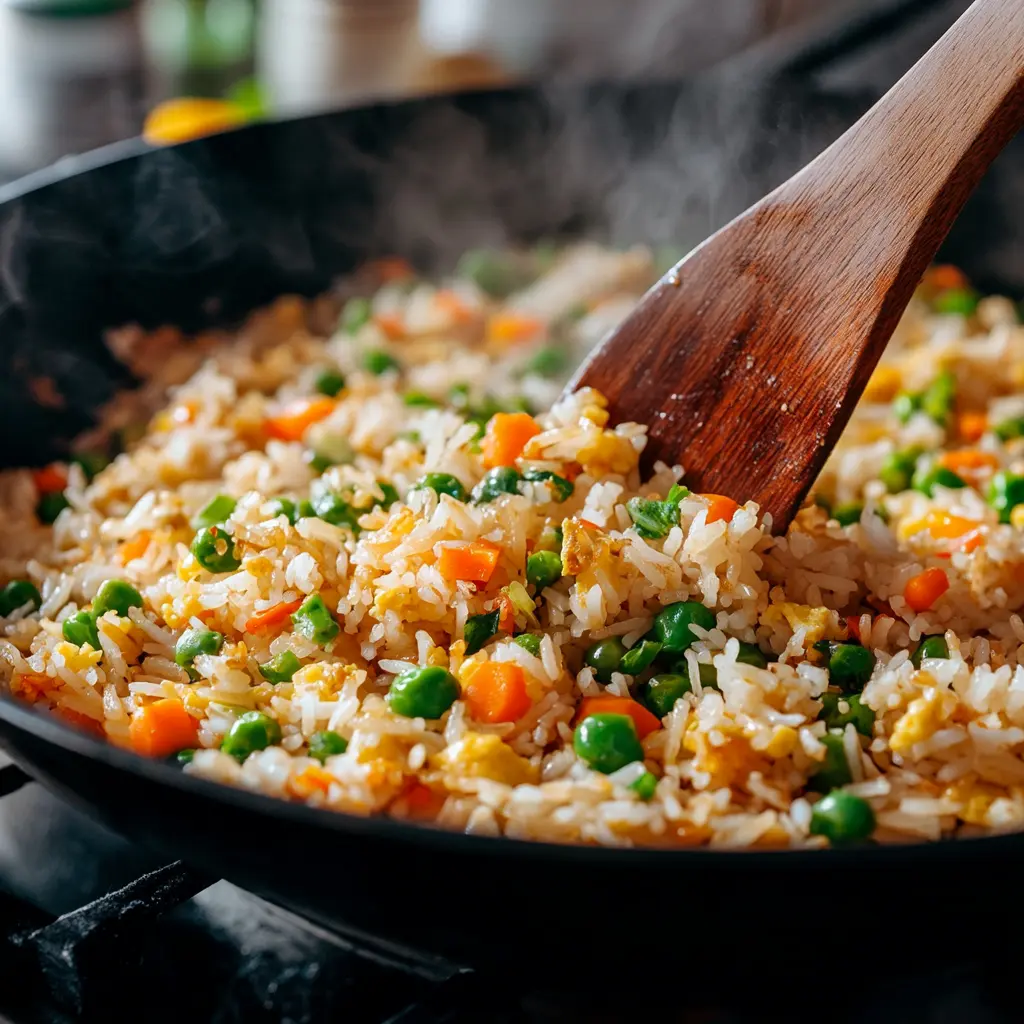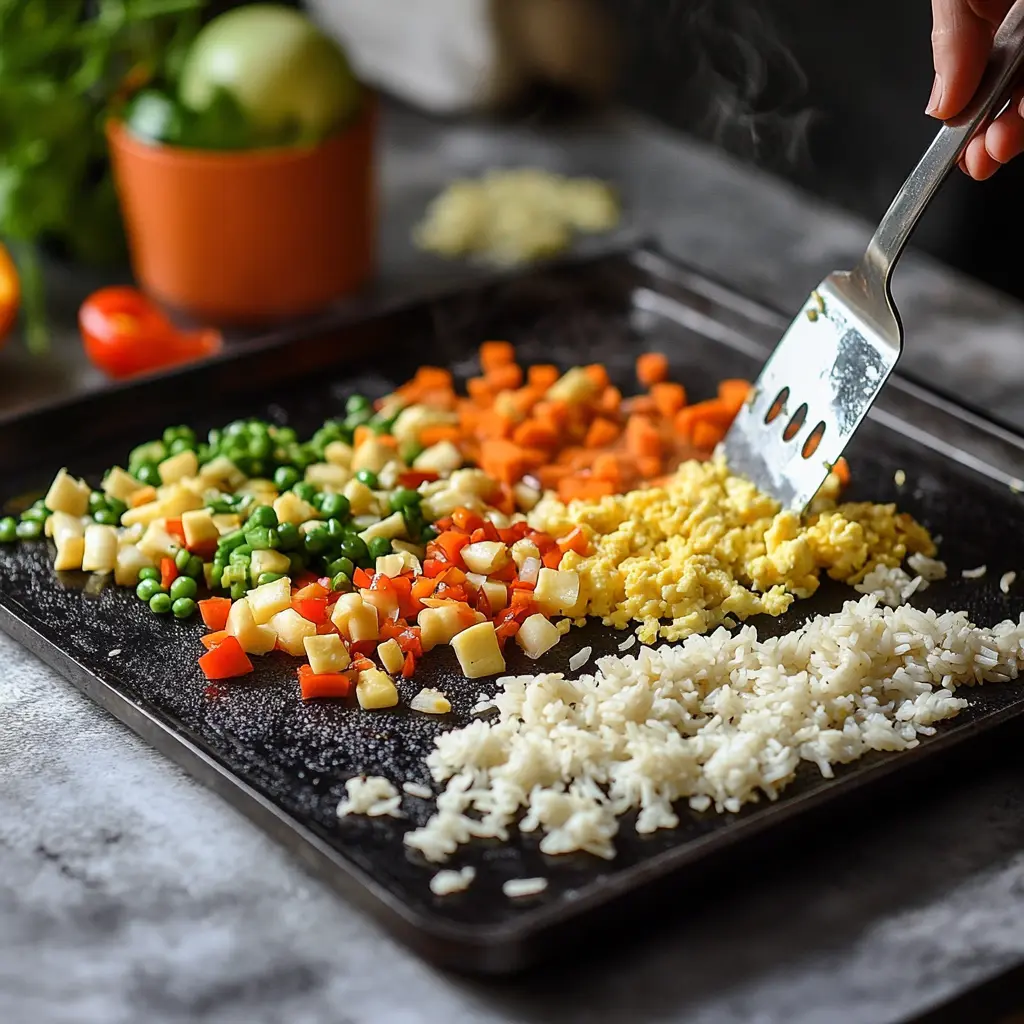
Fried rice is a versatile and beloved dish worldwide, known for its rich flavors and satisfying textures. Cooking it on a griddle can elevate its taste and appearance, providing a unique smoky quality and even cooking surface. But here’s the big question: What temperature should a griddle be for fried rice? Understanding and maintaining the correct griddle temperature is crucial for achieving that perfect balance of crispy edges, fluffy grains, and perfectly cooked add-ins like vegetables and proteins.
In this article, we’ll delve into the ideal griddle temperature for fried rice, the science behind it, and tips to ensure your fried rice is always restaurant-quality. Whether you’re a seasoned home cook or a beginner looking to try griddle cooking, this guide will set you up for success.
Table of contents
Understanding Griddle Cooking
What Is a Griddle?
A griddle is a flat, wide cooking surface, typically heated by gas, electricity, or charcoal. Its design allows for even heat distribution, making it ideal for various cooking tasks, from breakfast favorites like pancakes to versatile dishes like fried rice.
How a Griddle Differs from Other Cooking Surfaces
Unlike traditional stovetop pans or woks, a griddle provides a flat, spacious area for cooking multiple items simultaneously. This open surface ensures that ingredients spread out evenly, allowing for better heat exposure and reducing overcrowding—a common problem when using smaller cookware.
Advantages of Using a Griddle for Fried Rice
Cooking fried rice on a griddle has several benefits:
- Even Cooking: The uniform surface temperature prevents hot spots, ensuring consistent cooking for all ingredients.
- Ample Space: A griddle can accommodate larger batches, making it perfect for family meals or entertaining guests.
- Flavor Boost: The high heat creates a delightful caramelization on the rice and add-ins, enhancing the dish’s overall taste.
Ideal Temperature for Fried Rice on a Griddle
Recommended Temperature Range
The optimal temperature for cooking fried rice on a griddle is between 375°F and 400°F. This range strikes a balance between searing the rice quickly without burning it and keeping ingredients like eggs, vegetables, and proteins tender yet fully cooked.
Why This Temperature Is Ideal
Cooking fried rice at this temperature ensures:
- The rice grains crisp slightly, adding texture.
- Moisture in the vegetables evaporates quickly, preventing sogginess.
- Proteins like chicken or shrimp cook evenly without drying out.
Effects of Incorrect Temperature
- Too High: The rice and other ingredients can burn before they cook through, resulting in a bitter flavor and uneven texture.
- Too Low: The rice becomes mushy, and ingredients may release excess water, creating a steamed rather than fried effect.
Preparing the Griddle for Fried Rice
Preheating the Griddle
Preheat your griddle for about 5-10 minutes before adding any ingredients. This step is crucial to ensure an even cooking temperature across the surface.
How to Check Griddle Temperature
- Thermometer: Use an infrared or surface thermometer to check if the griddle has reached the desired temperature.
- Water Drop Test: Sprinkle a few drops of water on the griddle. If they sizzle and evaporate within 1-2 seconds, the griddle is ready.
Cleaning and Oiling the Griddle
Before cooking, clean the griddle to remove debris from previous meals. Apply a thin layer of high-smoke-point oil (like vegetable or canola oil) to prevent sticking and enhance flavor.
Cooking Fried Rice on the Griddle

Step-by-Step Guide to Making Fried Rice on a Griddle
Cooking fried rice on a griddle is both fun and straightforward. Follow these steps to create the perfect dish:
- Prepare Ingredients in Advance:
- Cooked and cooled rice (preferably day-old rice for better texture).
- Diced vegetables like carrots, peas, and onions.
- Proteins such as shrimp, chicken, beef, or tofu.
- Beaten eggs.
- Soy sauce, sesame oil, and seasonings like garlic or ginger.
- Preheat the Griddle:
Heat the griddle to 375°F–400°F and lightly oil the surface to prevent sticking. - Cook Proteins First:
Add your chosen protein to the griddle and cook until golden brown. Remove and set aside. - Scramble the Eggs:
Pour the beaten eggs onto the griddle. Scramble them quickly, then set aside with the protein. - Sauté Vegetables:
Add the vegetables to the griddle, stirring them frequently. Cook until they are tender but still slightly crisp. - Add Rice:
Spread the rice evenly over the griddle and stir occasionally, allowing it to fry and crisp up slightly. - Combine Everything:
Return the protein and eggs to the griddle, mixing them with the rice and vegetables. - Season the Dish:
Drizzle soy sauce and sesame oil evenly over the mixture, tossing it well to coat every grain. Adjust seasoning with salt and pepper if needed. - Serve Hot:
Transfer the fried rice to a serving dish and garnish with green onions or sesame seeds for extra flavor.
Tips for Evenly Cooked and Flavorful Fried Rice
- Spread Ingredients: Avoid piling everything in one spot; spread them out for even heat exposure.
- Work Quickly: Use quick, consistent movements to stir and toss ingredients for even cooking.
- Don’t Overcrowd: Cook in smaller batches if necessary to avoid steaming the rice.
Benefits of Cooking Fried Rice on a Griddle
Even Cooking
A griddle’s flat surface distributes heat evenly, ensuring that every grain of rice cooks uniformly without burning or clumping.
Enhanced Flavors
The high heat caramelizes the ingredients, imparting a smoky, savory quality to the fried rice that’s hard to achieve with other cooking methods.
Larger Cooking Space
A griddle’s spacious surface allows you to prepare larger quantities without compromising the quality, making it ideal for gatherings or meal prep.
Common Mistakes to Avoid
Skipping Preheating
Failing to preheat the griddle can result in uneven cooking and a lack of the crispy texture that defines good fried rice.
Overcrowding the Griddle
Adding too many ingredients at once can lower the griddle’s temperature, leading to steaming instead of frying.
Neglecting Temperature Adjustments
- Too Low: Cooking fried rice below 375°F leads to steaming rather than frying, causing mushy rice.
- Too High: Over 425°F risks burning the rice and creating an unpleasant charred taste.
Troubleshooting Temperature Issues
What to Do If the Griddle Isn’t Hot Enough
- Increase the heat gradually and allow the griddle to preheat for a few more minutes.
- Use a thermometer to ensure the temperature is within the ideal range.
Solutions for Overheating
- Lower the heat and let the griddle cool slightly before resuming cooking.
- Move ingredients to a cooler part of the griddle if possible.
Maintaining Consistent Temperature
- Cook in small batches to prevent heat loss.
- Use an infrared thermometer to monitor the surface temperature regularly.
Enhancing Your Fried Rice Recipe
Adding Proteins
Proteins like chicken, shrimp, beef, or tofu can transform fried rice into a complete, hearty meal. Here’s how to add them effectively:
- Marinate for Flavor: Before cooking, marinate proteins with soy sauce, garlic, and ginger to enhance flavor.
- Cook Separately: Ensure proteins are fully cooked before mixing them with the rice to avoid overcooking.
- Cut Into Small Pieces: Bite-sized portions cook faster and distribute evenly throughout the dish.
Incorporating Vegetables and Seasoning
Vegetables not only add color but also provide texture and nutrients to your fried rice.
- Choose Fresh or Frozen: Carrots, peas, onions, and bell peppers are popular choices. Frozen vegetables work well but should be thawed and drained to avoid excess moisture.
- Season Gradually: Add soy sauce, sesame oil, and any desired spices incrementally to avoid over-seasoning.
Achieving Restaurant-Quality Results
- Use Day-Old Rice: Day-old rice is less sticky, making it ideal for fried rice. Fresh rice can clump and become mushy.
- Layer Flavors: Add seasoning in stages during protein cooking, vegetable sautéing, and final mixing for a more complex flavor profile.
- Cook in Small Batches: This ensures every ingredient is evenly fried, retaining texture and flavor.
Expert Tips for Perfect Fried Rice on a Griddle
The Role of Oil
Oil is critical for preventing sticking and achieving crispy rice. Use oils with a high smoke point, such as vegetable, canola, or peanut oil. Avoid using too much oil, as it can make the dish greasy.
Timing for Adding Ingredients
- Start with the Hardest Ingredients: Proteins and firm vegetables (like carrots) should go on the griddle first.
- Add Rice in the Middle: After proteins and vegetables are cooked, add the rice to ensure it absorbs the flavors.
- Finish with Delicate Ingredients: Soft vegetables like peas or green onions, as well as seasoning, should be added last to retain freshness and vibrancy.
Mixing Techniques for Fluffier Rice
Use a spatula to flip and toss the rice gently but frequently. This helps separate the grains and ensures even distribution of ingredients and flavors.
Comparing Griddle vs. Wok for Fried Rice
Pros and Cons of Each Cooking Method
| Cooking Method | Advantages | Drawbacks |
|---|---|---|
| Griddle | – Larger cooking space- Even heat distribution- Ideal for batch cooking | – Requires careful temperature monitoring- Not as versatile for tossing ingredients |
| Wok | – Traditional method for fried rice- Easy to toss ingredients for even mixing- High heat use | – Limited cooking space- May create uneven cooking if not used on the right stovetop burner |
Situations Where a Griddle Might Be Better
Griddles excel when preparing fried rice for larger groups or when you need a consistent cooking surface. They also allow for better control over the layout of ingredients, making them great for avoiding overcrowding.
Adaptability for Different Cuisines
Griddles can be used for other dishes like Japanese teppanyaki or Korean fried rice, making them versatile for various cooking styles.
Cleaning and Maintenance of Your Griddle
How to Clean the Griddle After Cooking
- Allow the griddle to cool slightly before cleaning.
- Use a scraper to remove food debris gently.
- Wipe the surface with a damp cloth to remove any residue.
Seasoning the Griddle for Next Use
- Apply a thin layer of oil to the griddle while it’s still warm to maintain a non-stick surface.
- Store the griddle in a dry place to prevent rust.
Long-Term Care Tips
- Avoid using harsh cleaning agents that can strip the griddle’s seasoning.
- Perform a deep clean periodically to remove buildup.
Frequently Asked Questions (FAQs)
What Oils Are Best for Fried Rice on a Griddle?
High-smoke-point oils like vegetable, canola, peanut, or sesame oil are ideal. They can withstand high temperatures without breaking down, ensuring a non-stick surface and enhanced flavor.
Can You Cook Fried Rice on an Electric Griddle?
Yes, electric griddles are excellent for fried rice. Ensure the temperature is adjustable and set it to the ideal range of 375°F to 400°F.
How Long Does It Take to Cook Fried Rice on a Griddle?
On average, cooking fried rice on a griddle takes about 10–15 minutes. This depends on factors like the quantity of rice and the griddle’s heat retention.
Can I Use Frozen Vegetables Directly on the Griddle?
Frozen vegetables can be used, but it’s better to thaw and drain them beforehand to avoid excess moisture, which can make the rice soggy.
What Other Dishes Can I Cook Alongside Fried Rice on a Griddle?
You can cook dishes like grilled chicken, shrimp skewers, or even stir-fried noodles. A griddle’s large surface area makes it perfect for multitasking.
How Do I Avoid Sticking Rice to the Griddle?
Preheat the griddle, oil it lightly, and use day-old rice to minimize sticking. Additionally, avoid overcrowding the griddle to maintain consistent heat.
Conclusion
Cooking fried rice on a griddle is an excellent way to achieve a flavorful, evenly cooked dish. The key is maintaining the optimal temperature of 375°F to 400°F and using proper techniques, like preheating the griddle and layering flavors thoughtfully. With these tips, you’ll master the art of making fried rice that rivals your favorite restaurant’s version. Happy cooking!
